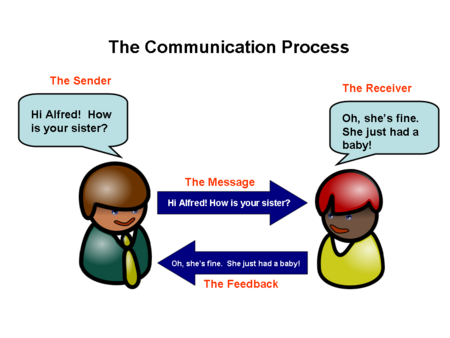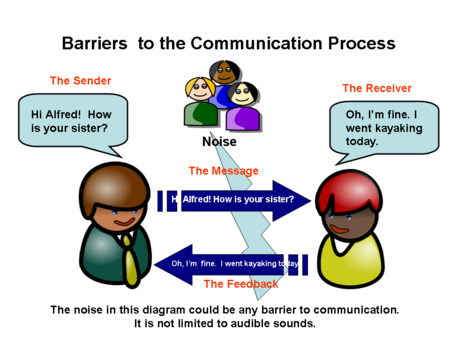VUSSC/Content/Tourism/Applying Effective Communication Skills/The process of communication
4. The process of communication
Communication can be very complex, as there are countless opportunities for sending or receiving the wrong message. You may think you understand a tourist’s request only to hear, “But that’s not what I meant!” You may also have received or given directions you thought were clear, yet still, you lost your way or misled someone in the process. In order to understand the complexity of the communication process you have to be familiar with the following terms we refer to as elements:
- Sender
- Receiver
- Encode
- Message
- Channel
- Decode
- Feedback
The figure below shows the key elements in the process of communication. The communication process is not very complex. It consists of nine elements, two of which involve the major players in the communications process namely, the sender and receiver. Then major communications tools are shown, which are the message and channel/media. The process by which we communicate involves the transmission of a message from the sender to the receiver, through a channel or medium. Communication is a two-way process, because the receiver then responds to the message (we call this giving feedback) and in this way he/she becomes the sender again, and the person who first spoke/wrote, becomes the receiver (of the feedback communication).
The descriptions that follow will help you understand the diagram.
Sender: A person sending a message to another person. This person begins the communication process. The sender has a responsibility to formulate a message that will communicate exactly what he/she means. This involves the use of communication symbols that will convey this meaning. The sender in tour guiding operations can be both the tour guide who presents tour commentaries and explain attractions, and the tourists who ask questions or make comments.
Receiver: The receiver is the person (for example the colleague or tourist) to whom the message (or communication) is directed. In tour guiding it can both be the tourists who are being addressed by the tour guide, or the tour guide receiving questions from the tour group.
Message: The reason for the communication process. It is the idea or information that the sender wants to pass on to the receiver. This is the encoded set of symbols that is conveyed by the sender and which consists of both verbal and non-verbal symbols that the sender wishes to transmit. The sender must formulate the message with clear language or symbols which will be easily understood by the receiver and which the receiver will be able to interpret accurately and respond to. The sender should also provide room for feedback in the message.
Channel: The channel is the medium through which the message is sent – for example whether it is sent verbally (by word in face to face or telephonic conversation), written (by writing such as memos, letters, faxes, e-mail) or signaled (by hand or other symbols). The channel carries the message from the sender to the receiver. In tour guiding operations the channel can be both verbal (for example tour commentaries or tourist questions), non-verbal (the tour guide or tourist’s body language supporting the messages) and print and electronic media (newspapers, television, internet, magazines, maps and brochures used to develop the tour guide’s commentaries).
Then there are four communication techniquess and these are:
- encoding,
- decoding,
- response, and
- feedback
Encoding: This technique is when the sender puts the message into language, symbols or signals, which may be understood by the receiver. The process of formulating the ideas of the message into meaningful symbols, words or signs, is known as encoding. It is important that the sender must encode the message in a way that it will be recognized and understood by the receiver, in order to make sure the receiver gets the message as intended by the sender.
Decoding: Decoding is when the receiver interprets the message and its meaning. Decoding is the process by which the receiver translates the symbols or words of the message into information that is meaningful to themselves. The process and success of decoding can be influenced by several factors, including a difference in perception and experiences between the sender and the receiver, as well as their different attitudes and what they already know about the topic of the communication. Different receivers could decode the same message differently, because of each one’s unique perception.
Responding: This is when the receiver or even the sender of the message performs an action and responds to the message received.
Feedback: The message has an effect on the receiver in terms of how they think it was intended, and they give a response (reaction) back to the sender based on the meaning they attach to the message. This response is called feedback. The feedback can be verbal, written or non-verbal. Even silence is non-verbal feedback, although it is often hard to interpret and can be misunderstood because it can either mean indifference, acknowledgement or a lack of understanding of the message. Because of all the different ways silence can be interpreted, this is known as negative feedback. It is important for tour guides to design feedback methods in a way that would encourage understanding and positive feedback. These can be done by encouraging comments and questions from tourists during a tour and feedback questionnaires or other evaluation methods following a tour.
The last element is a factor that can hinder the process at any stage, and that is noise.
Noise: Noise hinders effective communication throughout the communication process. Noise can be from the external (surrounding) environment, such as from too many messages at the same time or background noise that interferes with a clear understanding of the message. We also refer to some receiver characteristics as ‘noise’, and this is where their emotions, ethnic background, age, education level or disabilities may distort or make a message misunderstood. Noise in communication, is any distraction that interferes with the proper transmission of communication, so that the message from the sender cannot reach the receiver as it was intended by the sender to be understood. It is a major communication barrier, as we will see further on in this discussion. In tour guiding for example, noise can be the background sounds of animals at a site while the tour guide is explaining the attractions. It could also be the accent of the local tour guide, which may make it difficult for the tourists to understand the message he/she is trying to convey.
|
What do we call the following key players or elements in the communication process?: 1. A person sending a message to another person. 2. The person for whom the message is intended. 3. An encoded set of verbal and non-verbal symbols. 4. The process of formulating a message into meaningful symbols.
|
You must have identified the key players as follows:
1. Sender
2. Receiver
3. Message
4. Encoding
WELL DONE! You are now able to explain the communication process that tour guides and others use. We hope you will also enjoy our next section, on THE REASONS WHY WE COMMUNICATE. You may now attempt the next activity.
Remember!
It is important that all senders of communication must keep in mind who their target audience is, so that they can focus the message accordingly. The sender should know what the receiver’s perception is, so that the encoding can be in line with the receiver’s experiences. The sender should also use the appropriate communication channel to reach the receiver and invite feedback, so that they can confirm that the message was understood and appropriately responded to.

